Published
6 years agoon
By
Paul Martin
The raw material used to make Japanese swords is called tamahagane. On January 24, production of the annual batch of tamahagane for Japan’s swordsmiths began at the Nittoho tatara in Oku-izumo, Shimane prefecture.
The tatara is jointly run by the Society for the Preservation of Japanese Art Swords (Nittoho), in conjuction with the Agency for Cultural Affairs, and Hitachi Metals. Tatara murage (Supervisor) Akira Kihara, 82, is an appointed Living National Treasure for his skills in traditional tatara steelmaking, and has been in charge of production since 2002.
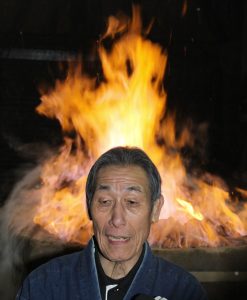
Oku-izumo in the San’in region has been a center of iron and steel production since the earliest times. Before the 8th century, the archaic provinces of Bizen, Bingo, Bitchu, and Mimasaka were collectively known as Kibi. Kibi lay upon one of the important trade routes that stretched across Japan and has always been a great resource of iron sand. In the ancient period, the Kibi were a powerful people who had a strong rice-based economy, and were equal in power to the Yamato clan, from which the imperial line would originate and later unite Japan.

Tamahagane means jewel-steel. It is called so because the glistening clumps of this type of bloom steel are speckled with metallic red, blue, and gold-colored patches. Tamahagane (also referred to as watetsu, or Japanese steel) is produced using iron sand (satetsu). The iron sand is collected from the riverbeds during spring and summer, and mined from the mountains during fall and winter so as not to pollute the rivers and disturb the local farmers during those seasons.
The process of making tamahagane is called tatara-buki. Tatara refers to the large clay furnace used to smelt the iron sand using charcoal from pine trees to raise the carbon content. However, the word tatara is also used generally to refer to the worksite where this traditional Japanese method of steel production takes place.
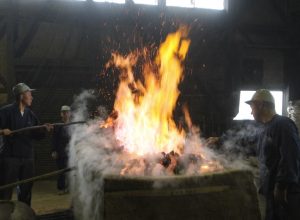
The clay furnace, or tatara, has the appearance of a large altar. One can sense immediately that this is no ordinary method of steel production, but a particularly Shinto experience that is performed in accordance with nature. The tatara clay furnace is approximately 2.7 meters long by 1 meter wide. The top edges curve downwards along its length, resembling the curvature of the torii-gate of a Shinto shrine. Prayers are performed in front of a nearby small Shinto shrine that houses the deity of metal production, Kanayago-no-kami, before production commences, and a portable shrine within the workshop overlooks the whole process. The workshop itself is separated from the material world by a sacred rope called a shimenawa.
Moisture is the enemy of steel production, so production usually takes place between late January and early February, when the humidity is at its lowest. To further remove moisture from the production site, the tatara furnace is built upon a large three-meter deep underground structure that has air ducts to help draw out the moisture during the steelmaking process.
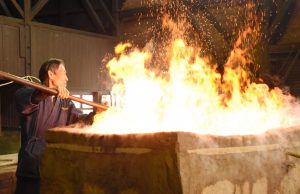
The tatara usually operates for three weeks, during which it is possible to complete three cycles of tatara-buki and produce three large blooms (kera) of iron and steel. The tatara clay furnace must be rebuilt from zero each time, using new clay bricks for each production cycle. The main phase of the tatara operation takes three days and nights. It is a non-stop cycle of smelting iron sand and charcoal by adding quantities of each one every 30 minutes for 72 hours.
The murage does not sleep for these three days. Like an expectant father, he watches the flames constantly for 72 hours. There are small holes along the sides of the tatara into which the pipes of the bellows are inserted. Some of these holes are widened so that he can intermittently check the condition of the bloom (kera) amassing in the base of the tatara. It is said that many murage lose their sight with age because they are constantly looking into the brightness of the molten steel.
The eerie slow rhythmic groan of the large automated bellows, the respiratory sound created by the draft, and continual rise and fall of the flames give reason to view the tatara as a living organism. This controlled process keeps the temperature in the furnace at around 1,500° C. The murage also checks the condition of the melting iron sand by inspecting the molten slag that is expelled through vent holes at the ends of the clay furnace. By the time the process is completed, some of the initial 20 to 40-centimeter thick silica furnace walls have reduced to around 10 cm as the remainder has become incorporated into the smelt, producing two tamahagane cores along both sides of the kera, where the air pumped in by the bellows provided optimum deoxidization.
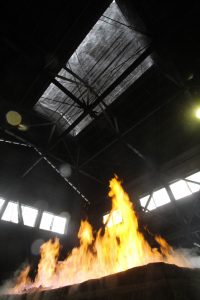
When the time is right, on the order of the murage, the walls of the tatara are sensationally torn down and the kera is revealed.
The kera is approximately 2.7 meters in length by 1 meter wide and 30 cm deep, and weighs from 2 to 2 1/2 tons. The outer surfaces of the completed blooms are covered in a mix of pig-iron, steel, semi-reduced steel, slag, and charcoal, etc., while the inner cores contain the first grade tamahagane that has an even distribution of carbon content of 1% to 1.5%. Other parts of the bloom contain second grade tamahagane that has a carbon content ranging between 0.5% and 1.2%, and zuku (pig-iron) with a carbon content of over 1.75%.
Finally, the kera is dragged out into the snow and allowed to cool to its core. Once it is fully cooled, it is broken into fist-sized chunks and graded by hand before being distributed to swordsmiths all across Japan.
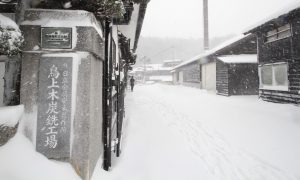
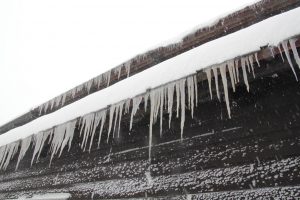

Paul Martin is a Japanese Sword Specialist.
(Click here to read the article in Japanese.)
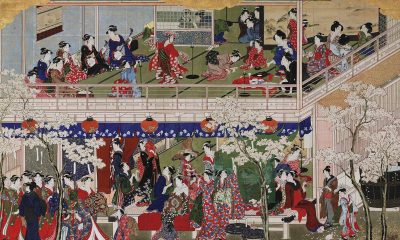

Yoshiwara, the Glamorous Culture of Edo's Party Zone


Hokusai and the Samurai World
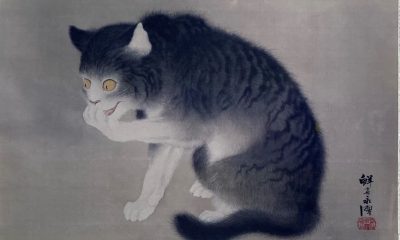

[A Visit to the Atelier] Discovering Kobayashi Eitaku, the Neglected Ukiyo-e Artist
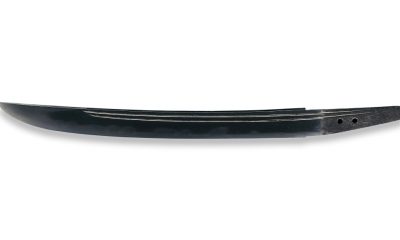

The British in Bakumatsu Japan: The Bizen Incident
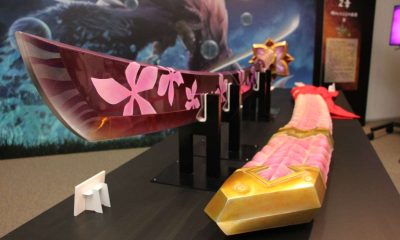

Master Swordmakers of Sakai Give 'Monster Hunter' Kakaru Kumo Nakai's Sword New Life
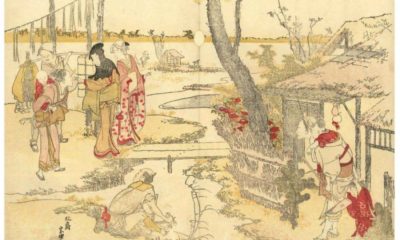

Sumida Museum Brings New Perspective to Hokusai's World of Printed Books

You must be logged in to post a comment Login